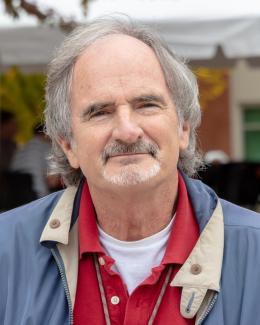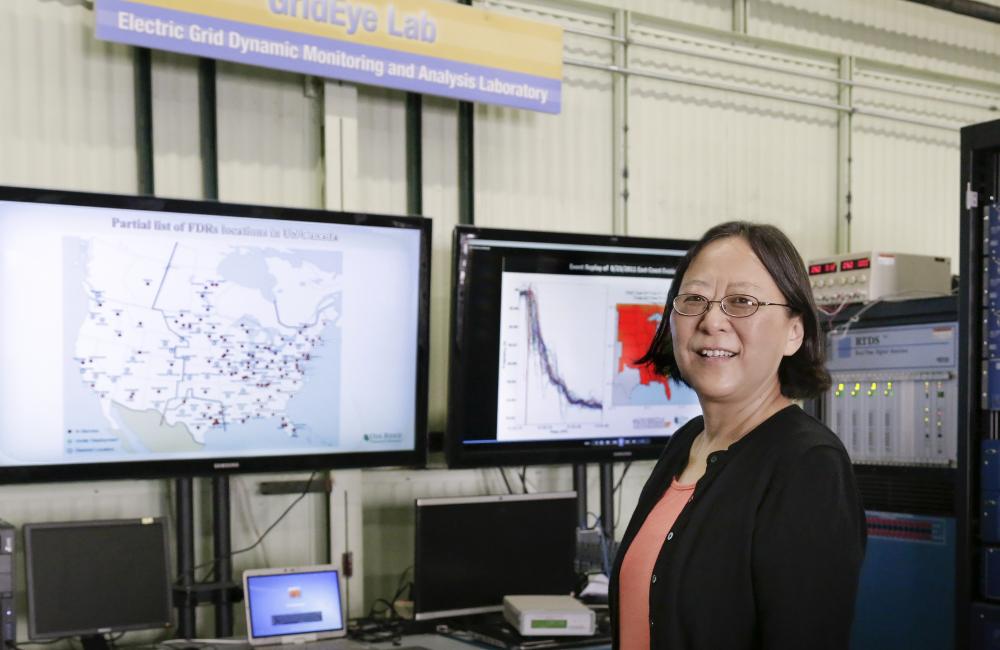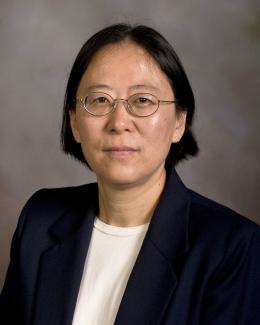February 28, 2017 – It’s an interesting time to be a power systems engineer: renewable generation is flourishing and bringing with it a unique set of challenges. For a researcher like Yilu Liu with a love of problem-solving and prowess in both engineering and science, the task of modernizing the aged electricity grid is a surprisingly enjoyable one.
Liu, the Governor’s Chair for Electronics, notes that her background and expertise fit well with Oak Ridge National Laboratory’s mission to help upgrade the grid and seamlessly integrate renewable energy. The Governor’s Chair is a joint appointment between ORNL, where Liu works in the Power & Energy Systems group, and the University of Tennessee, where she is a professor in the Department of Electrical Engineering and Computer Science.
“What’s interesting for me personally in my work is constantly dealing with new discoveries and knowledge—to identify new problems and solve them. Almost every day I get to see some new results from my students,” she said. And at ORNL, “you get to have a lot of national influence on research direction. You have a voice to point out where the real problems are, and your opinion is respected. That is very motivating.”
Liu’s work has focused on wide-area measurement of power grids, such as the development of ORNL’s FNET GridEye system that monitors electrical disturbances across the country using 120-volt outlets in homes and businesses, along with a triangulation algorithm that Liu has patented. The result is a system currently providing automatic alerts to more than 200 industry members, DOE, and other federal agencies.
As an undergraduate in China, Liu considered pursuing a career in medicine. She chose instead to focus on power systems, and came to the US already trained as a high-voltage engineer. She earned her MS and PhD at Ohio State University and taught electrical engineering at Virginia Tech before moving to Tennessee.
Among the challenges she’s working on these days are the development of extremely fast, accurate sensors to capture electromechanical movement on the grid, as well as large grid network simulations that can predict how the grid will function if more renewable sources such as wind and solar are added. “There is much work to be done in the grid area these days because of renewables. With these resources there isn’t a constant supply of power to match the [demand] load on the system,” she noted.
Going forward, Liu envisions even more grid work. “If there’s one area where I’d like to see big progress, it’s energy storage. Once that happens, it will change the landscape. It could be a huge new future, as exciting as going to Mars.”
In addition to her research, Liu is an active mentor at ORNL and the university. Although the graduate-level classes she teaches cover different technical elements, “I have a common theme,” she said. “I want to teach my students how to conduct research. How you approach it, how you formulate a problem and go about solving it.” She proudly notes that of the students she has taught, 35 now hold PhDs and 34 have earned master’s degrees; she also has mentored 36 post-doctoral researchers. Among her own accomplishments, Liu in 2016 was inducted into the National Academy of Engineering and the National Academy of Inventors.
In her time away from the lab, Liu enjoys gardening, with a particular interest in cultivating fruit trees. She has an extensive variety, and tends to them carefully—bagging the grapes in her vineyard and the fruit on many of her trees to deter scavengers, for instance.
Despite a very busy life, she has never lost her interest in medicine. “I like to read about medical advances, and I watch surgical videos. It’s fascinating,” Liu said. “Maybe I’ll go into medicine when I retire.”
UT-Battelle manages ORNL for the DOE's Office of Science. The Office of Science is the single largest supporter of basic research in the physical sciences in the United States, and is working to address some of the most pressing challenges of our time. For more information, please visit http://energy.gov/science/— By Stephanie Seay.




